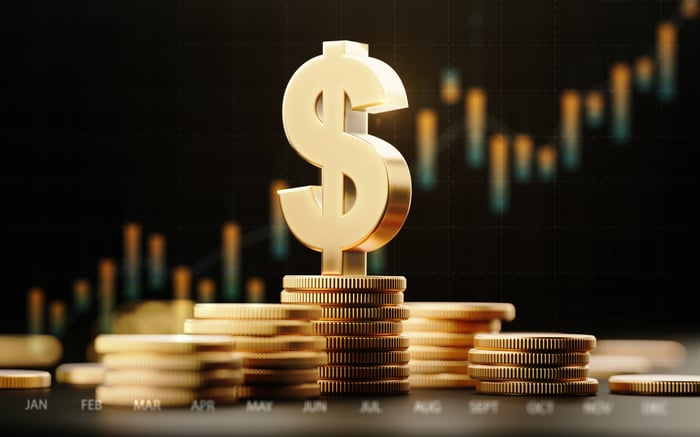Geoffrey Kendrick, who leads digital asset research at Standard Chartered, has consistently been among the most optimistic analysts on Wall Street regarding cryptocurrencies. While some of his predictions have leaned toward the optimistic side, he accurately anticipated that Bitcoin ( BTC 3.20%) would surpass $100,000 in 2024.
Kendrick now projects that Bitcoin could reach $500,000 by 2028, representing a 355% increase from its current value of $110,000. He also forecasts that XRP ( XRP 3.63%) could climb to $12.50 in the same timeframe, which would be a 345% gain from its present price of $2.80. In both scenarios, Kendrick points to a more favorable regulatory environment as a key driver.
After returning to office, President Trump quickly issued an executive order to establish a task force aimed at bolstering U.S. leadership in digital assets. He also signed another order to create a national digital asset reserve and a strategic Bitcoin stockpile, appointing crypto supporter Paul Atkins as the new chairman of the Securities and Exchange Commission (SEC).
Earlier this year, the SEC also withdrew Staff Accounting Bulletin (SAB) 121, which had required banks to list digital assets held for clients as liabilities on their balance sheets—a rule that discouraged many from offering custody services. With SAB 121 revoked, that barrier has been removed, likely paving the way for greater institutional involvement. Continue reading for a deeper look at the investment case for Bitcoin and XRP.

Image source: Getty Images.
1. Bitcoin
Bitcoin, the largest cryptocurrency with a market capitalization of $2.1 trillion, has seen its popularity soar since spot Bitcoin ETFs were approved in January 2024. This milestone not only provided a regulated way to invest in Bitcoin, lending it greater legitimacy, but also unleashed pent-up demand from both institutional and retail investors by removing the complexity and high costs of crypto exchanges.
Notably, the iShares Bitcoin Trust by BlackRock attracted $37 billion in net inflows last year, making it the most successful ETF debut ever, according to The Wall Street Journal. Its momentum has only grown since. The iShares Bitcoin Trust is now among the top 25 ETFs by assets under management (AUM), and overall AUM for all spot Bitcoin ETFs has nearly tripled over the past year.
Of particular significance is the growing participation from institutional investors, who collectively manage around $128 trillion in assets. Recent 13F filings show that twice as many institutions held positions in the iShares Bitcoin Trust in Q2 2025 compared to the previous year, with the total value of those holdings increasing more than fivefold. In summary, institutional investors are taking larger and more numerous positions in Bitcoin.
Looking forward, I anticipate that more corporations and institutions will incorporate digital assets into their investment strategies, with Bitcoin likely being the top pick. Bitwise CIO Matt Hougan commented earlier this year, "Bitcoin stands as the leader among crypto assets—it's the largest, most liquid, and most established. In my view, it's comparable to digital gold and is the only cryptocurrency with the potential to become a globally significant currency."
2. XRP
XRP serves as the native token of the XRP Ledger, a blockchain designed to enable quick and low-cost international payments. The main growth driver for XRP is Ripple, a fintech company that delivers payment solutions to banks and enterprises, some of which utilize the XRP Ledger.
Ripple provides a variety of services, including on-demand liquidity, which uses XRP as a bridge asset: funds are converted to XRP, transferred via the XRP Ledger, and then exchanged back to the original currency. However, Ripple also offers payment solutions that do not involve XRP, and these are more widely adopted by financial institutions.
The SWIFT (Society for Worldwide Interbank Financial Telecommunications) messaging system is the industry standard for international wire transfers, processing roughly 53 million transactions daily. However, these transfers are often costly due to multiple intermediaries and can take several days to complete.
As a result, Ripple CEO Brad Garlinghouse recently predicted that XRP could capture 14% of SWIFT's transaction volume within five years. Such a development could send XRP's price soaring, but I remain skeptical that it will reach that level. While XRP does offer faster and cheaper transfers, the volatility of cryptocurrencies remains a significant concern for most financial institutions.
To address this, Ripple has introduced a stablecoin called Ripple USD (RLUSD) into its network. RLUSD, pegged to the U.S. dollar, is a more stable bridge currency, and transactions involving RLUSD still require XRP for fees. This could boost demand for XRP, but other stablecoins like USDC currently enjoy greater popularity.
Lastly, Geoffrey Kendrick identifies the potential approval of spot XRP ETFs as a major catalyst. Since the green light for spot Bitcoin ETFs in January 2024, Bitcoin has surged 135%, suggesting that XRP could also benefit if similar products are approved, though likely to a lesser extent. The SEC is expected to rule on at least six spot XRP ETF applications by October 23.